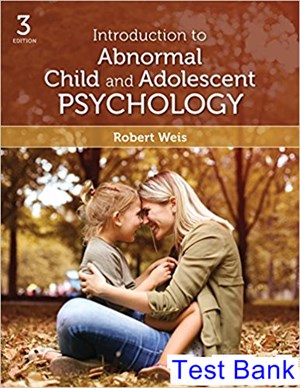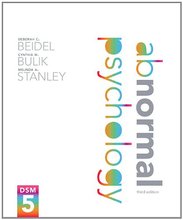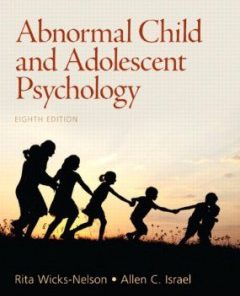Introduction to Abnormal Child and Adolescent Psychology 3rd Edition Weis Test Bank
$35.00 Original price was: $35.00.$26.50Current price is: $26.50.
Introduction to Abnormal Child and Adolescent Psychology 3rd Edition Weis Test Bank
Introduction to Abnormal Child and Adolescent Psychology 3rd Edition Weis Test Bank

Product details:
- ISBN-10 : 150633976X
- ISBN-13 : 978-1506339764
- Author: Robert Weis
Robert Weis′ third edition of Introduction to Abnormal Child and Adolescent Psychology adopts a developmental psychopathology approach to understanding child disorders. Using case studies, this perspective examines the emergence of disorders over time, pays special attention to risk and protective factors that influence developmental processes and trajectories, and examines child psychopathology in the context of normal development. Designed to be flexible via its focused modular organization, the text reflects the latest changes to the DSM (DSM 5, 2013) and is updated with new research and developments in the field.
Table contents:
1. The Science and Practice of Abnormal Child Psychology Welcome to the Study of Abnormal Child Psychology Prevalence of Childhood Disorders Social and Demographic Influences on Childhood Disorders The Rise of Pharmacotherapy Child Mental Health in the United States Differentiating Normal and Abnormal Behavior in Children Defining Abnormal Behavior in Children The Psychiatric Definition of Abnormality Abnormality, Ethnicity, and Culture Understanding the Development of Psychopathology Probabilistic Epigenesis Developmental Pathways Distinguishing Normality from Abnormality The Importance of Understanding Normal Development Focus on Individual Differences in Development Risk and Resilience The Science of Abnormal Child Psychology Integrating Science and Practice Scientifically Informed Practice Clinically Informed Research Students and Emerging Scientists and Practitioners 2. The Causes of Child Psychopathology: Research Methods and Theories The Scientific Study of Behavior Three Features of Scientific Inquiry Determining Causality Hypothesis Testing Experimental Research Correlational Research Correlations and Causality Types of Correlational Studies Special Relationships Between Variables Moderators Mediators Research Methods Genetic Influences on Development Biological Influences on Development Behavioral Influences on Development Family Influences on Development Socio-Cultural Influences on Development 3. Assessing and Diagnosing Children?s Problems Psychological Assessment Purposes of Assessment The Four Pillars of Assessment Assessment Techniques Clinical Interviews Behavioral Observations Norm-Referenced Testing Evaluating Psychological Tests Clinical Decision-Making Diagnosis DSM-IV-TR Advantages of Diagnosis Disadvantages of Diagnosis Stigma Multiaxial Diagnosis 4. The Practice and Ethics of Psychotherapy with Children What is Psychotherapy? Common Factors in Therapy Systems of Psychotherapy Child Psychotherapy History Child vs. Adult Psychotherapy Does Child and Adolescent Psychotherapy Work? Psychotherapy Research Psychotherapy Efficacy Does Child and Adolescent Psychotherapy Work? What Therapies Work Best? Caveats in Efficacy Research: Effectiveness Empirically Supported Treatments 5. Mental Retardation and Intellectual Disabilities What is Mental Retardation? DSM-IV-TR Definition of Mental Retardation The AAIDD Definition of Mental Retardation Associated Characteristics Stereotypies Self-Injurious Behaviors Comorbid Mental Health Problems Epidemiology Etiology Organic vs. Cultural-Familial Mental Retardation Similar Sequence and Similar Structures Behavioral Phenotypes Known Causes of Mental Retardation Cultural-Familial Mental Retardation Treatment Prenatal Screening Infant and Preschool Prevention Educational Interventions Behavioral Interventions Medication 6. Autism and Other Pervasive Developmental Disorders What are Pervasive Developmental Disorders? Autistic Disorder Asperger?s Disorder Rett?s Disorder Childhood Disintegrative Disorder Pervasive Developmental Disorder, NOS The Autism Spectrum Associated Features and Disorders of the Autism Spectrum Epidemiology of Autism Spectrum Disorders Prevalence Gender and Ethnicity Course Etiology of Autism Spectrum Disorders Genetics Biological Causes Deficits in Social Cognition Treatment Home-Based Treatments School-Based Treatments Medication Interventions with Little Empirical Support Best Practices 7. Learning Disorders and Academic Problems What are Learning Disorders? Learning Disorders Learning Disabilities Identifying Learning Disabilities Epidemiology Prevalence Gender Ethnicity and Socioeconomic Status Course Genetic Bases for Learning Disorders Reading and Writing Mathematics Reading Disorder: Basic Reading Normal Development of Basic Reading Skills Causes of Basic Reading Problems Treatment Reading Disorder: Fluency and Comprehension Normal Development of Fluency and Comprehension Causes of Fluency and Comprehension Problems Treatment Disorder of Written Expression Normal Development of Writing Skills Causes of Writing Problems Treatment Mathematics Disorder Normal Development of Mathematics Skills Causes of Mathematics Problems Treatment 8. Attention-Deficit/Hyperactivity Disorder What is Attention-Deficit/Hyperactivity Disorder? Combined Type Predominantly Hyperactive-Impulsive Type Predominantly Inattentive Type Associated Disorders Associated Characteristics Parent-Child Interactions Peer Relationships Academic Difficulties Epidemiology Prevalence Gender and Ethnicity Course Etiology Genetics Brain Structure and Functioning Pre- and Perinatal Risks Barkley?s Neurodevelopmental Model Treatment Medication Psychosocial Treatments Medication vs. Psychosocial Treatment 9. Conduct Problems in Children and Adolescents What are Child and Adolescent Conduct Problems? Oppositional Defiant Disorder Conduct Disorder Overt vs. Covert Symptoms Reactive vs. proactive Aggression Child- vs. Adolescent-Onset Associated Features and Disorders Epidemiology Prevalence Gender and Ethnicity Course Etiology Genetics Temperament and Early Neurological Development Parent-Child Interactions Social Information Processing Peer Interactions Neighborhoods Causes of Adolescent-Onset Problems Treatment Treatment for Younger Children Treatment for Older Children and Adolescents 10. Substance Use Disorders in Adolescents What are Substance Use Disorders? Substance Abuse Substance Dependence Problems Diagnosing Substance Use Disorders in Adolescents Alcohol and Marijuana Use, Abuse, and Dependence Alcohol: Effects on Brain and Behavior Marijauna: Effects on Brain and Behavior Associated Disorders Epidemiology Prevalence of Substance Use Prevalence of Substance Abuse and Dependence Gender Ethnicity Course Etiology Enhanced Reinforcement Model Negative Affect Model Deviance-Prone Model Treatment Primary Prevention Programs Secondary Prevention Programs Psychosocial Treatments 11. Depressive Disorders in Children and Adolescents What are Depressive Disorders? Major Depressive Disorder Dysthymic Disorder Depression: Categorical or Dimensional? Associated Disorders Epidemiology Prevalence Gender and Ethnicity Course Etiology Genetics Neurotransmitters Temperament HPA Dysregulation Stress and Coping Cognition Interactions with Parents Interactions with Peers Treatment Antidepressants Cognitive Behavioral Therapy Interpersonal Psychotherapy for Adolescents Combining Medication and Psychotherapy 12. Bipolar Disorders in Children and Adolescents What are Bipolar Mood Disorders? Bipolar I Disorder Bipolar II Disorder Cyclothymic Disorder Bipolar Disorder, NOS Bipolar Disorders in Children vs. Adults Associated Characteristics and Disorders ADHD and Conduct Problems Substance Use Problems Anxiety and Suicide Psychotic Symptoms Family, School, and Peer Problems Epidemiology Prevalence Gender and Ethnicity Course Etiology Genetics Brain Structure and Functioning Environmental Experiences Treatment Medication Psychosocial Treatment 13. Anxiety Disorders in Children and Adolescents What is Child and Adolescent Anxiety? Conditioned Fear Disorders Specific Phobia Social Phobia Posttraumatic Stress Disorder Unconditioned Fear Disorders Panic Disorder and Agoraphobia Separation Anxiety Disorder Obsessive Compulsive Disorder Worry Generalized Anxiety Disorder Treatment Behavior Therapy for Phobias Cognitive-Behavior Therapy for Social Phobia, SAD, and GAD Trauma-Focused Therapy for PTSD Cognitive-Behavior Therapy for Panic Disorder Exposure with Response Prevention for OCD Pharmacotherapy 14. Eating Disorders in Adolescents What are Adolescent Eating Disorders? Anorexia Nervosa Bulimia Nervosa Distinguishing Anorexia from Bulimia Problems Diagnosing Adolescents Associated Features Psychiatric Disorders Personality Characteristics Associated Problems Epidemiology Prevalence Eating Problems in Boys Culture and Ethnicity Course Etiology Genetics Serotonin and Colycystikinen Sexual Development Cognitive-Behavioral Theory Sociocultural Theories Treatment Inpatient Treatment for Anorexia Family Therapy for Anorexia Outpatient Treatment for Bulimia Medication 15. Child Abuse and Neglect The Significance of Child Maltreatment Definition Physical Abuse Sexual Abuse Psychological Abuse Neglect Epidemiology Effects of Physical Abuse and Neglect Physical Health Behavior Problems Mood and Anxiety Problems Quality of Attachment Cognitive Delays Effects of Sexual Abuse Traumatic Sexualization Betrayal Powerlessness Stigmatization Why Do Adults Physically Abuse and Neglect Children? Parents? Information Processing Social-Cultural Theory Why Do People Sexually Abuse Children? Men Women Adolescents Treatment for Physical Abuse and Neglect Supportive Therapy for Children Parent Training Cognitive-Behavioral Family Therapy Ecological Approaches to Treatment Treatment for Child Sexual Abuse Trauma-Focused Therapy for Children Cognitive Restructuring for Adolescents References Index About the Author
People also search:
introduction to abnormal child and adolescent psychology 3rd edition
introduction to abnormal child and adolescent psychology 3rd edition pdf
explain adolescent psychology
what is child and adolescent psychology
common mental health problems in childhood and adolescence
You may also like…
Test Bank
Test Bank for Child and Adolescent Development An Integrated Approach, 1st Edition: Bjorklund












